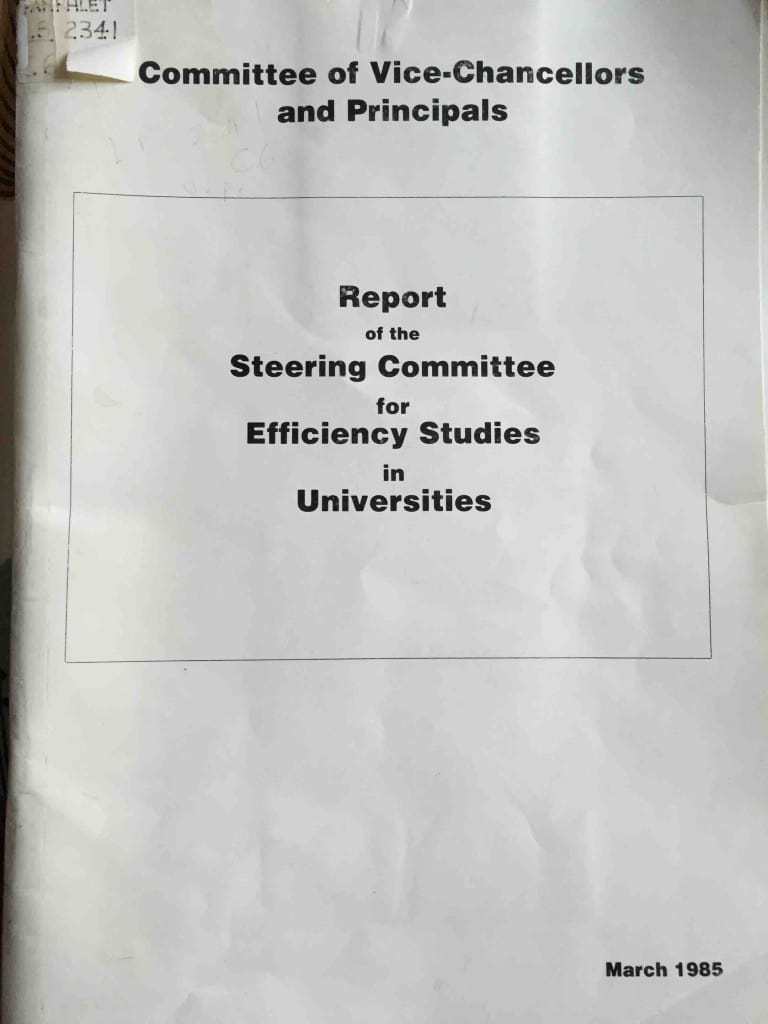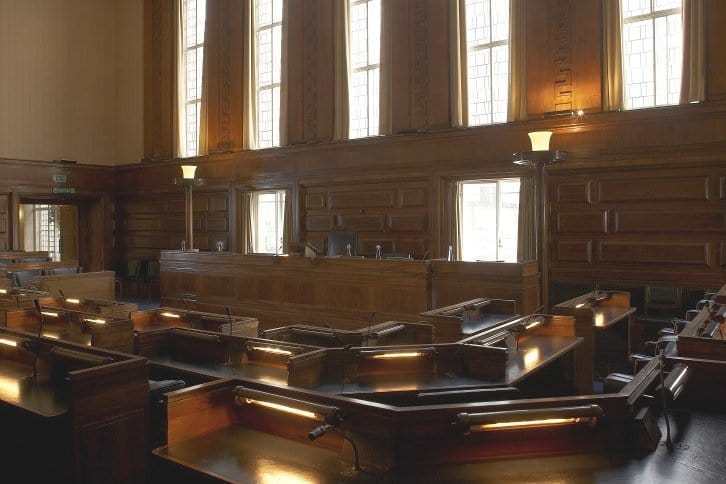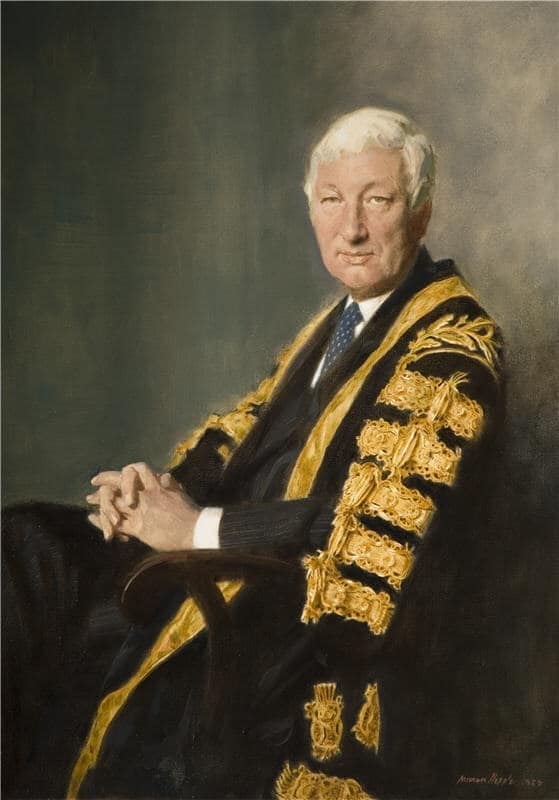On the Report of the Steering Committee for Efficiency Studies in Universities

Back in 1984 a committee was established by the (Committee of Vice-Chancellors and Principals (CVCP, forerunner of UUK) with Sir Alex Jarratt (then Chairman of Reed International and Chancellor of Birmingham University) in the chair. It had a brief to “promote and co-ordinate a series of efficiency studies” in a small number of universities. This was then further framed by the Committee itself as an examination of:
whether management structures and systems were effective in ensuring that decisions are fully informed, that optimum value is obtained from the use of resources, that policy objectives are clear, and that accountabilities are clear and monitored.
There was explicit avoidance of matters concerned with academic policy and judgement.

Another country
Higher education was a different world then: still a binary system and with the biggest university of the six involved being Edinburgh with just under 10,000 students (one of whom was me), this really was a another age.
Universities were still coming to terms with the consequences of three years of major cuts imposed by the Thatcher Government in 1981. The University Grants Committee (UGC) was reassessing its process of allocation of resources for research and teaching in light of further below inflation increases in government funds (although it is interesting in the current TEF context to note that the “UGC has no present intention of taking into account quality of teaching, as it has no reliable way of assessing it”). This was also a time of UGC-determined student numbers and the Committee had determined a reduction in students in order to maintain the unit of resource. According to Jarratt a “typical university will receive 64% of its funding direct from the UGC and 13% in the form of tuition fees”.
Jarratt argued that changes were therefore required if universities were to be able to achieve their aims. The report noted that the management structure of some universities led to a response which was “a mixture of “equal misery” and “random misery””. Jarratt notes some universities had grown their collaborations with industry but suggests this will not make much of a financial difference and cautions that whilst they may generate some income there would be opportunity costs and “may even erode academic standards”. International students too should be seen as “a valuable source of income”. Whilst stressing the importance of the constitutional autonomy of universities the report notes its significant limitations in practice. In this context therefore Jarratt was concerned that universities “set up the necessary structure and procedures to maximize the effectiveness of their limited resources”.
A big fuss
The findings and recommendations though were hugely controversial . The Jarratt Report, as it quickly became known, was produced in March 1985 and caused a major stir despite what sounds like a fairly innocuous core premise: “The search for value for money is desirable at any time; in an era of constrained funding it becomes essential”.
Some of the key findings then which prompted all the fuss:
- Strategic planning doesn’t happen and is generally regarded as “too difficult”.
- Resource allocation occurs largely on a historical base and changes incrementally. No explicit account is taken on the relative strength of departments nor is there any systematic use of performance indicators.
- Resource allocation mechanisms are generally fragmented and there is no clear view of the whole.
- The quality and extent of management information, including basic financial data, to inform management is inconsistent and generally under-developed.
- Committees and the structures which deal with resource allocation issues are not effective and the division of responsibilities between the Senate and Council are often unclear. There needs to be a “single unifying body which can integrate financial and academic policies” across the two.
- Budgetary control arrangements are under-developed and there is little formal accountability for the use of resources.
In making his recommendations, Jarratt noted that significant constraints on a changed approach include government short termism, the attitude to tenure, the general view that planning stifles creativity. Effective strategic and corporate planning is difficult in this context, suggested Jarratt, but necessary for institutional success. The very basic remedies outlined, including the establishment of a joint Senate and Council planning and resources committee and proper budgeting arrangements, seem now to be extremely modest but at the time they were seen as explosive.
Senates, Councils and lots of committees
Commenting on formal structures Jarratt observes that lay members of Councils are valuable and important contributors who could be called upon to provide a great deal more support in terms of strategic and financial planning. Noting that Councils had become, on the whole, weaker in the decades prior to the report, Jarratt recommended that their position be reinforced and that a creative tension between the Senate and the Council (rather than harmony) was necessary given the circumstances faced by universities.

The report notes that typically “a university has between 50 and 100 committees reporting to either Council or Senate”. And there are more at lower levels. Beyond support for joint Senate and Council committees the report is clear of the value of a proper committee structure for academic matters but also recognises the cost of an elaborate committee architecture and the need to delegate authority to officers on many operational matters. The bolstering of these formal arrangements by many informal processes, some of them involving lay members of Council, was felt to be a very valuable contributor to institutional function.
Chief executives and academics
Jarratt has quite a lot to say about university officers too. Vice-Chancellors needed to be seen as chief executives as well as academic leaders (a particularly controversial point) and should be selected through a proper process involving lay Council members. Pro-Vice-Chancellors, Deans and Heads of Department are key roles and clarity was required in the definition of their duties, responsibilities and reporting lines.
Staff appraisal for academics to aid recognition of their contribution, assist with their development and to ensure the most effective deployment of staff is also proposed. This is something which is still an area of discussion and debate within many institutions. Jarratt also proposed appraisal for administrators which has been implemented with less dispute.
Other ranks
In terms of administrative staff the report notes that “there is agreement that the administrations serve their universities well”. Whilst the cuts were generally felt more strongly in the administration and workloads increased, administrators continued to play an important role. There is strong encouragement to give junior administrators wider experience by moving them around departments. Greater delegation to senior administrators is also recommended as is the proposition that the “administration should be treated as one for the purpose of resources so as to maximize the possibility of redeployment as changes occur in needs and priorities”. Five of the six universities under consideration – Edinburgh, Essex, Loughborough, Sheffield and UCL – were unitary administrations at the time with Nottingham the only binary one (Registrar and Bursar). Fast forward three decades and there has been significant change at all six, with only one still being in a position close to a unitary administration. A different world.

All change please
The report makes a set of recommendations to government and to the UGC (including, rather far-sightedly, collaborative purchasing consortia, academic computing networks and on-line library catalogues) as well as to universities themselves. There are also a couple of interesting comments on the Universities Statistical Record, a forerunner to HESA, which note the reluctance of universities to allow release of data “which would enable individual institutions to be put in “league table” order”. It didn’t last much longer.
In making its recommendations for institutional change it is appropriate to note that the report was hugely positive about the critical role of universities as “assets of immense national importance” and in recognizing the crucial dependence on academic freedom for institutional success. These are not platitudes.
Concluding, Jarratt summarises the need for change and argues that the key to success is “planning for selectivity and having the means to achieve it”. Universities were therefore asked to draw up plans for implementing the recommendations of the report, reviewing their own organization and streamlining in order to make improvements to deliver value for money.
Universities were urged to adopt structures and methods which “can rapidly identify and manage change, yet be sufficiently sensitive to the academic aims of a university and the need to involve academic staff” and which will not damage the “essential academic character and role of the institution”

The ultimate betrayal?
Looking back from 2015, some of these observations and recommendations do seem quite tentative. But in 1985 they were dynamite. After the extraordinary and unprecedented cuts of 1981 and Keith Joseph’s unsuccessful approach to introduce fees in 1984 this seemed like another attack on universities. As a student at the time I can well remember the contempt with which academic staff uttered the name Jarratt. Memories persist: Geoffrey Alderman in the Times Higher in 2009 reviewing Malcolm Tight’s book Higher Education in the United Kingdom Since 1945 was scathing:
But to my mind one of the most damaging inquiries into higher education over the last half-century was the Jarratt report published in 1985. To devote just four pages to a mischievous and malevolent investigation (which, inter alia, popularised if it did not invent the notion that students are “customers”, which foisted on the sector the delusion that factory-floor “performance indicators” are entirely suited to a higher-education setting, and which led to the abolition of academic tenure and the concomitant triumph of managerialism in the academy) is – indeed – “foolhardy”.
Jarratt was self-inflicted. The inquiry was not a government creation. It was established by the Committee of Vice-Chancellors and Principals. How well do I remember them, running around like a clutch of headless chickens, trying to fool us youngsters that Maggie Thatcher would love us if we acquiesced in Jarratt, and might even restore some of the cuts she had so savagely and so enthusiastically imposed!
Jarratt was betrayal from within.
Powerful stuff. But Jarratt was not responsible for all of this (and indeed has virtually nothing to say about students, let alone students as “customers”). Looking back these do not look like the proposals filled with malevolence or mischief. Many of these changes were inevitable, most were long overdue, a lot would have happened in any case as universities responded to the new competitive landscape. From today’s viewpoint it looks more like that what Jarratt offered were some pointers and directions in this strange new terrain. Surely very few were genuinely seduced by the notion that to follow Jarratt was to appease Thatcher. Nevertheless, the symbolic significance of the report should not be understated.
Was Jarratt a betrayal then? No. But neither was it that radical although it undoubtedly had a profound impact, way beyond its modest recommendations.











